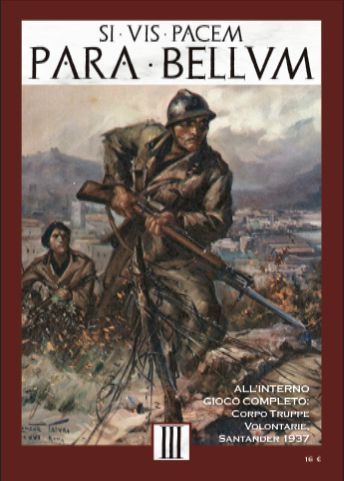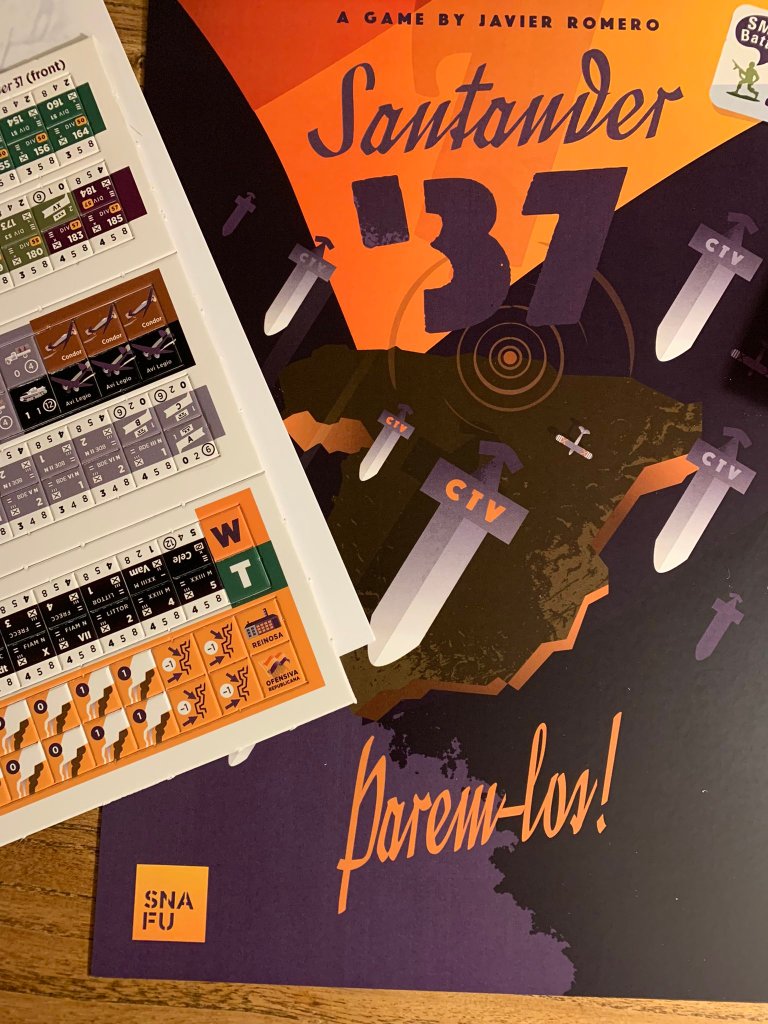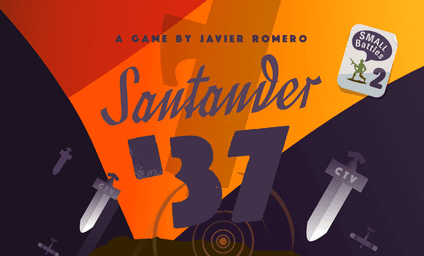We became familiar with the work of Javier Romero when we played his game Lion of Judah: The War for Ethiopia, 1935-1941 from Compass Games in 2017. A few months ago, I saw where Javier was designing a game on the Nationalist offensive into Santander in 1937 during the Spanish Civil War and I immediately reached out to him and he was more than willing to talk with us.

Grant: What is your game Santander ‘37 about?
Javier: It is a simulation of the Nationalist offensive against Santander, in August 1937 during the Spanish Civil War of 1936-1939. Regiment-Brigade level, 2-day turns. Playable in a couple of hours, features one small sized map and about 100 counters.
Grant: What inspired you to design a game revolving around the Nationalist offensive against Santander in the Spanish Civil War?
Javier: Well, it is a rather interesting campaign. Generally considered a sideshow, in fact its outcome was decisive. Had the Republicans resisted until the arrival of winter, the Northern zone could have resisted until the spring of 1938, giving time to the Republican Army to create a solid army. The Republican forces resisted well, but they were defeated by a combination of maneuver and firepower, as well as tactical mistakes by the Republican forces. With the fall of Santander in August 1937, the Nationalists had plenty of time to clear the Northern zone before the onset of winter. This gave them access to the crucial mining, industrial and human resources of the North.
Grant: I understand this game originally appeared in the Italian wargaming magazine Para Bellum in 2018. What has changed with the game since that iteration?

Javier: Yes, the Italian magazine Para Bellum (http://www.parabellum-magazine.com/) published a first version back in 2018 called Corpo Truppe Volontarie: Santander 1937. The developers have changed a bit the combat and morale rules and added some extra rules to entice the Republican to counterattack. They have also added their trademark stacking rules-there is normal stacking, operational overstacking and physical overstacking. Overstacking is not forbidden per se, but it has a number of disadvantages. Artillery fire on overstacked hexes get a positive modifier, for instance. Overstacked units are also disorganized (more on this later).
Grant: What elements of this campaign as well as the Spanish Civil War did you need to include in the design?
Javier: Well, I had to reflect firepower superiority (the Nationalists enjoyed a clear superiority in artillery and airpower, with plentiful ammunition, at least for Spanish Civil War standards). And, of course, factionalism-there are Basque, Santander and Asturias units, with the Basques surrendering if certain conditions are met. Airpower is included as well, but I wanted to include operational attrition-if a player uses all its air units in a single turn they might not be available next turn (they return as “reinforcements” two turns later). I wanted players to manage their assets and apply concentration of forces, not attacking just for the sake of it. For a detailed history, see the historical article at http://www.parabellum-magazine.com/downloads/Santander_ENG.pdf
Grant: What sources did you consult to get the details of the history correct? What one source would you recommend as a must read?
Javier: There isn’t yet a canonical history of the northern campaign. Most older sources can be problematic and/or biased, as happens in all civil wars everywhere, although this has changed in recent decades. Unfortunately, there are no English sources on the military history of the Spanish Civil War. The one source I would highly recommend on the Spanish Civil War campaigns is the monographic issues published by Desperta Ferro magazine that provide up-to-date research on that conflict along with outstanding maps and graphics. https://www.despertaferro-ediciones.com/

Grant: Who is the artist for the game and how does their style positively effect the play experience?
Javier: Map and counters for this second edition were designed by Nils Johansson (https://twitter.com/zweigefuhle). His style is highly immersive, for he does extensive research of the graphic design of the era. His map and counters are inspired by the art and graphics of the 1930’s. His work doesn’t cause indifference-most players either love or hate it. It is true that his innovative approach can take a bit to get used to, but I think that the visual experience is worth the effort.
Grant: What region of Spain does the map cover? What unique terrain is involved and what challenges does it create?
Javier: The map covers most of the Santander province and surrounding areas. This region has an Atlantic climate and is separated from the central plateau by a mountain range with peaks reaching 2,000 meters. Most valleys run north to south, with very limited movement from east to west and vice versa. The Republicans occupied a “bridgehead” south of the mountain range, the Reinosa pocket, in the upper Ebro Valley, conquered in the summer of 1936 as a springboard for a march on to Northern Castile. Keeping that pocket would cost them dearly in 1937.

Grant: What is the force structure of units? What different type units are included for each OOB?
Javier: Most units in the Spanish Civil War were infantry, although in the OOB there are a few tank units (Nationalist, Republican and Italian) and even motorized Italian detachments formed by light armor, truck borne infantry and cavalry. There are also HQ units that can provide artillery support, and air units. Tanks can be used to spearhead attacks, taking the first step loss and providing extra modifiers on the attack. Issue #38 of Alea Magazine will also include special rules and counters for naval support units. https://alealudopress.com/

Grant: What was your greatest challenge in devising the OOB?
Javier: Unlike, say, 30 years ago, now we have plenty of information about the OOB of the campaigns of the Spanish Civil War. There is, however, a problem with some older secondary sources. Some of them mention units that never existed, a mistake that is repeated, again and again, by several different books (see, for instance, the map in page 19 of the historical article http://www.parabellum-magazine.com/downloads/Santander_ENG.pdf ). There is an author, for instance, that cites the existence of a Republican battalion “formed by marine infantry” deployed between Santander and Asturias. This unit never existed.
Grant: What different factions are represented on each side?
Javier: On the Republican side: we have Santander (XV Corps), Basque forces (XIV Corps) and Asturias (XVI Corps). The Nationalist have regular forces, Italian forces (CTV) and joint Italo-Spanish forces with Italian officers and NCO’s and Spanish NCO’s and rank and file. There is, of course, the Legion Condor, Nazi Germany’s contribution to the Nationalist effort.
Grant: What is the anatomy of the counters?
Javier: Units have the standard attack-defense-movement factors, with step loss markers (2 or 1). Republicans are further color coded depending on region (Basques, Asturias, Santander).

Grant: What is the general Sequence of Play?
Javier: It is rather classic. There is a weather phase followed by a Republican offensive elsewhere check (this simulates offensives in the central front that force the Nationalist player to withdrawn units and air support for use in those battles). Then there is movement-combat for the Nationalist, followed by movement-combat for the Republican. During the Republican sub-phase they check for Basque surrender and Reinosa factory demolition. There is an end of turn phase where DSG units can rally and HQ’s are flipped back to their “support” side.
Grant: How does combat work in the design?
Javier: Combat is odds-based. It is not mandatory to attack adjacent units. Attacks are usually preceded by air and artillery bombardment. In general, air and artillery bombardment causes DSG results (higher results can inflict step losses, but this is not the usual thing). DSG units are weakened (halved) and get negative die roll modifiers on the CRT.
Grant: Anything unique or interesting about the CRT?
Javier: High odds attacks can get a B (Breakthrough) result, eliminating all defenders and turning extra step losses into advance hexes. Logistic units can be used to add a column shift on the attack or increase the weight of bombardment. This simulates accumulation of ammunition-the Nationalist player (the Italians in particular), had plenty of ammunition, while the Republicans had scarce artillery and scarce ammunition.
Grant: What is disorganization and how dues it effect units performance?
Javier: There are several levels of DSG results: DSG0, DSG1 and DSG2. DSG units (either 0, 1 or 2) have their combat and movement factors halved. HQ units have their bombardment strength reduced to 0. A DSG0 unit that becomes DSG again gets a DSG1 marker, and a DSG1 unit getting a DSG result gets a DSG2. DSG2 units getting another DSG result lose a step. Units within 2 hexes of a friendly HQ can reduce their DSG level by one.

Grant: How do trench markers effect attacks? How much were trenches used historically?
Javier: Trenches protect from bombardment (-1 DRM to bombardment die rolls) and from enemy attack (-1 DRM on the CRT). The mountains were excellent defensive terrain, although the Republicans lacked resources and equipment to build extensive fortified lines.
Grant: How does Bombardment work? What units can perform bombard?
Javier: HQ and air units perform bombardment. The attacking player adds up the total number of units performing bombardment against a single hex, then rolls on the Bombardment table. Logistic units add extra factors (this represents extra ammunition).
Grant: How does Logistic units effect Bombardment?
Javier: They add factors to the bombardment. Logistic units are in either support mode (they can provide support to attacks or bombardments) or movement (they can move, but they cannot provide support). So a rapid breakthrough leaves behind the logistic units that must be moved up front. Logistic units can only move through roads, and there are very few roads on the map.
Grant: Why is Republican Morale tracked and what effects does it have when lowered?
Javier: Although the Republicans fought well, after the front was broken there was a morale collapse, with many units trying to reach ports or Asturias. While Asturias units are not affected by morale level, the Santander units, recruited in a region predominantly conservative, surrendered quickly. Losing certain towns and cities lowers the Republican morale. The lower the Republican morale level, the less units that can reduce their DSG level at the end of the turn (that is, if at the end of a given turn Republican Morale is 4, four Republican units can reduce their DSG level from DSG0 to no DSG, or from DSG1 to DSG0.

Grant: What is the Republican offensive?
Javier: The Republican high command tried to delay as much as possible or stop altogether the Nationalist offensive in the North by launching several different offensives: June 1937 at Segovia, July 1937 at Brunete, and August-September 1937 at Belchite. Depending on the success of the Republican offensive, the Nationalist must withdraw troops and air support for the central front.
Grant: What causes the Basque to surrender and what effect does this have?
Javier: The Basque Corps (XIV Corps) was defending the last remnants of Basque territory. Once they lost the last remnants of Basque territory, the Basque Nationalists (battalions formed by the PNV Basque Nationalist party) lost any interest in the war and agreed to surrender with the Italian local commander. That was the Santoña Pact that precipitated the collapse of the Santander front, with disastrous results in the long term for the Republican cause. At the end of each turn, the Republican player rolls for Basque surrender. There are a series of modifiers (Basque Brigades destroyed or located east of hex row xx15). If the die roll is lower than the current Republican Morale, the Basque forces surrender.
Grant: How is victory achieved?
Javier: Victory is assessed in terms of Republican Morale. If Republican Morale goes over 5 at any time or is greater than zero during the End of Turn phase of turn 7, the Republican player wins. If Republican Morale drops below zero at any time, the game ends immediately and the Nationalist player wins. Republican counterattacks can increase their morale, while losing towns and the Basque surrender decreases their morale.
Grant: What optional rules are included and why?
Javier: There are two optional rules included (tanks played a small role in this campaign) and the Republicans deploy a company of Trubia Model 1936 tanks, a local design, along with venerable Renault FT-17 tanks. Another optional rule is a Italian unit that didn’t fought in the historical campaign. As I said earlier, there are optional rules and counters for Republican blockade runners (the Republican player gets one extra logistical unit if he can avoid interception by enemy naval forces), and naval support for both the Nationalist and Republican forces.
Grant: What are you most pleased about with the outcome of the design?
Javier: Well, I think that it is a design that conveys well the historical campaign and, despite of its small size, it has considerable replay value. And I think that the Santander campaign deserved a game.
Grant: What type of experience does the game create for players?
Javier: In general the Nationalist is on the offensive, but the Republican player can derail their offensive by well timed counterattacks. The Nationalist have several different options- attack the Reinosa pocket? Attack along the coast? A combination of both axis?
Grant: What other designs are you currently working on?
Javier: I am currently working on several designs for a number of publishers. Decision Games will publish two of my designs during 2022, Caporetto 1917-18, a game on the last year of the War on the Italian Front of WW1, and Chaco 1932-35, my take on that forgotten South American conflict (unfortunately, there are not many Chaco games around there). I am also working on a game on Soviet Partisan warfare in Ukraine and Belarus in 1943-44 for Paper Wars Magazine, as well as a game on the naval campaign in the Mediterranean in 1942 for VUCA Games.

If you are interested in Santander ’37 you can order a copy from the SNAFU Design website at the following link: https://snafustore.com/en/content/9-snafu-design
-Grant

Excellent interview!
LikeLiked by 1 person
Thanks Marti. I will say that Javier makes it pretty easy as he is just such a detail oriented designer and makes games with such depth that it is easy to highlight the cool stuff.
LikeLike
Grant thank you for doing this interview.
I had recently purchased this game and Ambon from SNAFU.
Interviews like this with the background and information you provide, push the games onto the table and provide for an even better gaming experience.
LikeLiked by 1 person
OK Grant… a WONDERFUL interview, as always!
SCW???… I’m already there! This game looks really good. After just outfitting my “Help Arrives” from DRACO IDEAS, then this? What a JOY! Looks like a real winner! Is the game out already? Will have to read the interview once more.
LikeLiked by 1 person